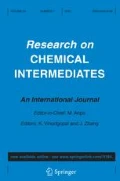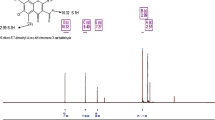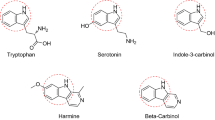Abstract
The mixed ligand complexes were synthesized using quinolin-8-ol and substituted chromone derivative with transition metals like Mn(II), Cu(II), Ni(II) and Co(II). These complexes were characterized using elemental analysis by electron dispersive spectroscopy, Fourier transforms infrared, ultraviolet–visible, proton nuclear magnetic resonance, liquid chromatography coupled with mass spectrometry, electron spin resonance spectra, magnetic susceptibility, powder X-ray diffraction, thermogravimetric analysis and scanning electron microscopy. The complexes were screened by biological activities such as antioxidant activity by 2, 2-Diphenyl-1-picrylhydrazyl, antimicrobial activity by the agar well-diffusion method and anticancer activity by yellow tetrazolium (3-(4, 5-dimethylthiazolyl-2)-2,5-diphenyltetrazolium bromide methods. The synthesis of mixed ligand complexes were synthesized by using homoleptic complexes of respective metal complexes of chromones. The FTIR spectra show νM–O the νM–N frequencies are obtained at 515–645 cm−1 and 431–496 cm− 1 respectively. The NMR spectra of Ni(II) complexes were indicating the complexes are paramagnetic in nature. The ESR spectra of copper complexes shows singlet signal, and they indicate that the copper has 2 + oxidation state in complexes. The complexes showed a well-defined crystal system indicated by powder-X-ray diffraction patterns. The thermogram studies show formation of metal oxides residues at the end product of decomposition of complexes. The scanning electron microscope showed complexes were nanocrystalline in nature. The mixed ligand complex of Ni(II) shows 80.73% antioxidant activity as compared to both the ligands and other metal complexes. The antibacterial activity result obtained clearly showed that all complexes were effective against all the microorganisms of Staphylococcus aures, Bacillus subtilis, Escherichia coli and Pseudomonas aeruginos. The inhibition of the cancerous cell is more the case of Ni (II) complexes as compared with other complexes.










Similar content being viewed by others
References
N.S. Youssef, K.H. Hegab, A.E. Eid, Synth. React. Inorg. Metal-Org. Chem. 37, 1647 (2007)
Z.H. Chohan, M.S. Iqbal, S.K. Aftab, J. Enz. Inhib. Med. Chem. 47, 223 (2010)
C.M.M. Santos, V.L.M. Silva, A.M.S. Silva, Molecules 22, 1665 (2017)
D.E. Nichols, C.F. Barfknecht, D.B. Rusterholz, F. Benington, R.D. Morin, J. Med. Chem. 16, 480 (1973)
C.M.M. Santos, A.M.S. Silva, A. Lévai, ARKIVOC. 2012, 265 (2012)
L. Lei, Y. Xue, Z. Liu, S. Peng, Y. He, Y. Zhang, R. Fang, Sci. Rep. 5(1), 1 (2015)
D. Hyuk, K. Yong, C. Sang, Y. Sup, Eur. J. Med. Chem. 45, 4288 (2010)
A. Novel, Tetrahedron Lett. 13, 1183 (1974)
E.R. Jamieson, S.J. Lippard, Chem. Rev. 99, 2467 (1999)
D.M. Boghaei, S.J.S. Sabounchei, Synth. React. Inorg. Metal-Org. Chem. 30(8), 1535 (2000)
B. Wang, Z.-Y. Yang, M. Lü, J. Hai, Q. Wang, Z.-N. Chen, J. Organomet. Chem. 694, 4069 (2009)
I. Tinoco, Annu. Rev. Phys. Chem. 53, 1 (2002)
P. Jayaseelan, S. Prasad, S. Vedanayaki, R. Rajavel, Int. J. Pharmac. Res. Synth. 1, 80 (2010)
A. Dziewulska-ku, J. Therm. Anal. Calorim. 101, 1019 (2010)
J. Wiley, Special Trends Therm. Anal. 45, 1605 (1995)
M. Patil, R. Hunoor, K. Gudasi, Eur. J. Med. Chem. 45, 2981 (2010)
Vilsmeier Haack, Aus d. Chem. Laborat. d. Universitat Erlangen 119(16), 4 (1926)
O. Meth-cohn, B. Tarnowski, A. Heterocycl. Chem. 31, 207 (1982)
K. Fries, G. Finck, Chem. Ber. 41(3), 4271 (1908)
G. Jones, S.P. Stanforth, Org. React. 56(2), 355 (2000)
S. Khan, W. Ahmad, K. Munawar, S. Kanwal, Indian J. Pharm. Sci. 80(3), 480 (2018)
S.A. Khan, S. Shahid, W. Ahmad, U. Fatima, S. Knawal, Indian J Pharm Sci. 80(1), 173 (2018)
T. Mosmann, J. Immunol. Methods 65, 55 (1983)
S. Basak, S. Sen, S. Mitra, C. Marschner, W.S. Sheldrick, Struct. Chem. 19, 115 (2008)
K. Rizwan, N. Rasool, R. Rehman, T. Mahmood, K. Ayub, T. Rasheed, G. Ahmad, A. Malik, S.A. Khan, M.N. Akhtar, N.B. Alitheen, M. Nazirul, M. Aziz, Chem. Cent. J. 12, 84 (2018)
M. Aslantaş, E. Kendi, N. Demir, A.E. Şabik, M. Tümer, M. Kertmen, Spectrochim Acta Part A Mol. Biomol. Spectrosc. 74, 617 (2009)
D.P. Singh, R. Kumar, V. Malik, Transit. Metal Chem. 32, 1051 (2007)
D.X. West, D.X. West, A.E. Liberta, Coord. Chem. Rev. 123, 49 (1993)
P. Kavitha, K. Laxma Reddy, Arab. J. Chem. 9(4), 596 (2016)
N. Ahmad, M. Alam, P. Kumar, A. Hashmi, R. Wahab, Asian J. Chem. 25(18), 10386 (2013)
F. Yakuphanoglu, I. Erol, Y. Aydogdu, M. Ahmedzade, Mater. Lett. 57, 229 (2002)
L.A. Saghatforoush, R. Mehdizadeh, F. Chalabian, J. Chem. Pharm. Res. 3(2), 691 (2011)
W. Ahmad, S.A. Khan, K.S. Munawar, Trop. J. Pharm. Res. 16(5), 1137 (2017)
M.A.R. Bhuiyan, M.Z. Hoque, S.J. Hossain, World J. Agric. Sci. 5(3), 318 (2009)
S.A. Khan, S. Shahid, S. Kanwal, G. Husaain, Dye. Pigment. 148(C), 31 (2017)
S.A. Khan, S. Shahid, S. Kanwal, K. Rizwan, T. Mahmood, K. Ayub, J. Mol. Struct. 1175(C), 73 (2018)
G. Hussain, S.A. Khan, F. Noreen, S. Kanwal, A. Iqbal, Mater. Sci. Eng. C 82(C), 46 (2017)
Acknowledgements
The authors are very grateful to Principal Dr. Muktaja Mathkari, MES, Abasaheb Garware College, Pune and Principal Dr.B.H.Zaware, New Arts Commerce and Science College Ahmednagar for support and providing a laboratory facility. Authors are thankful to HOD, Prof. R.C.Chikate, MES, Abasaheb Garware College Pune for encouragement. Authors are thankful for BCUD, Savitribai Phule Pune University for providing funds under a minor research project (Project No. 14SCI000295).
Author information
Authors and Affiliations
Corresponding author
Electronic supplementary material
Below is the link to the electronic supplementary material.
Rights and permissions
About this article
Cite this article
Kolhe, N.H., Jadhav, S.S. Synthesis, characterization and biological activity of mixed ligands complexes of quinolin-8-ol and substituted chromones with Mn(II), Co(II), Ni(II) and Cu(II) metal ions. Res Chem Intermed 45, 973–996 (2019). https://doi.org/10.1007/s11164-018-3656-x
Received:
Accepted:
Published:
Issue Date:
DOI: https://doi.org/10.1007/s11164-018-3656-x




